Case Management Statement and Case Management Conferences
Templates and Forms
Under the Case Management Program (CMP), all cases are scheduled for a Case Management Conference approximately six months after filing. You are required to file a Case Management Statement (CM-110) no later than 15 calendar days before your Case Management Conference. This guide shows how to complete that form.
Different counties have different local practices. In Sacramento, the Case Management Program only applies to unlimited civil cases (amount demanded exceeds $35,000). Check your local county court to determine whether your case is required to follow the CMP rules.
There is no fee for filing a Case Management Statement.
In Sacramento: Limited civil cases (amount demanded is $35,000 or less) are excluded from the Sacramento County Superior Court’s Civil Case Management program. Sacramento County Local Rule 2.21. See our guide on completing the Limited Civil Case Status Memorandum for more information on that process.
In other counties: check your county’s local rules to see if you are required to participate in the Case Management Program.
When is the Case Management Conference? The Court usually sets the Case Management Conference date when the case is filed and provides the plaintiff with a Notice of Case Assignment and Case Management Conference. The plaintiff is required to serve this on all defendants along with the Complaint. (At the time of this update, the first Case Management Conference in new cases is being scheduled for 11 months after the case is filed because the court is significantly backlogged.)
If you are a defendant and did not receive the Notice, check the court’s Case Portal. The Notice of Case Assignment and Case Management Conference will be one of the earliest documents in the “Document Download” list. You can download that, and any other documents, for free.
The Court may call for more than one Case Management Conference during the course of a lawsuit.
Where is the Case Management Conference? In Sacramento, specific departments hold the Case Management Conference (currently Departments 38 and 43). These procedures and departments change from time to time. For current information, check the court’s Case Management Program web page.
In Sacramento, parties are permitted to attend remotely via Zoom or telephone, unless the court orders you to appear in person. In other counties, check your local court to determine where the conference is held and whether and how you can appear remotely.
What happens at a Case Management Conference? The conference is related to status and scheduling. For instance, whether all parties have been served and answered, what discovery is needed, and when the parties will be ready for trial. No other matters will be discussed. Motions related to other matters are usually filed and heard in the Law and Motion department.
Free Video: Completing Your Case Management Statement. This guide goes into detail about how to answer the different questions, such as questions about whether you request a jury trial, what the different options for Alternative Dispute Resolution are, and how to estimate the length of trial you expect.
Tentative Rulings: Your conference may be canceled. If the Case Management Statements show that the case is progressing normally, the judge usually cancels the in-person hearing. The Court publishes tentative Case Management Orders the court day before the scheduled Case Management Conference, which may state that the conference is not necessary and is canceled.
Access these Tentative Rulings on the Court’s website at after 2:00 p.m. the court day before the Case Management Conference to determine if you need to make an appearance. Search for your case, then view the documents in the case to read the tentative ruling.
Step-by-Step Instructions for Case Management Statement
1
Complete the Necessary Forms
The Judicial Council form commonly used in this procedure is:
A sample filled-in form with instructions is available at the end of this Guide.
2
Completing Paragraph 10c of the Case Management Statement (Alternative Dispute Resolution)
You may find these definitions helpful in deciding which, if any, Alternative Dispute Resolution process you wish to participate in:
Mediation: A process in which people that are having a dispute are helped by a neutral third person (a Mediator) to communicate so they can reach a settlement acceptable to both. Mediation seeks a middle ground, and is often used when the parties will need to have contact in the future.
Settlement Conference: The parties and their attorneys meet with a settlement judge who hears both sides and tries to help them reach a compromise. The judge cannot make any decisions regarding the outcome, but will listen to each side, giving his or her critique and advising what they would be likely to decide in court. In Sacramento County settlement conferences are mandatory two weeks before trial; however, parties may elect to have an earlier settlement conference in order to avail themselves of the judge’s insight at an earlier stage of the process.
Neutral Evaluation: A neutral third party (an experienced individual, usually an attorney) issues an opinion on the issues he or she is asked to evaluate by the parties. An objective evaluation by a knowledgeable outsider can sometimes move parties away from unrealistic positions, or at least provide them with more insight into their cases’ strengths and weaknesses. This opinion has no effect on the case except for providing information useful for negotiation.
Non-binding Judicial Arbitration: A neutral third party Arbitrator, provided by the court, renders an opinion on the case. The Arbitration Award can be rejected and if so, the case will continue on to trial.
Binding Private Arbitration: The parties agree to hire a third party Arbitrator, and for the Arbitrator’s decision to be final, and enforceable in the courts.
3
Service of Documents by Mail on All Parties
Choose a server (person over 18 who is not a party) to mail the Case Management Statement to the other party(s).
Make one copy of your Case Management Statement for each other party.
Fill out a Proof of Service by Mail (POS-030), but do not have your server sign it yet. Make one copy for each other party.
Have the server mail a set of forms (one Case Management Statement and one Proof of Service by Mail) to each other party, or their attorney if they have one. Use normal first class mail, not certified or registered mail.
After mailing, have your server date and sign the Proof of Service by Mail.
For more details on how to fill out the Proof of Service by Mail, see our Proof of Service by Mail guide.
4
Copying and Assembling
Make two copies of each:
- Case Management Statement (CM-110)
- Proof of Service by Mail (POS-030) (signed)
In the Sacramento County Superior Court, because documents are scanned into a computer, any multiple page original documents are left unstapled, while each copy is stapled. In courts that do not electronically scan, all are stapled, and the original is two-hole punched at the top of the page for insertion into a folder.
5
Filing
In Sacramento, Case Management Statements are filed in the drop box in the first floor lobby at the Sacramento Superior Court at 720 Ninth Street. Fill out and attach the Civil Document Drop-Off Sheet, and date stamp the back of the original packet. A supply of Civil Document Drop-Off Sheets and a date stamp are located near the drop box. Following the instructions posted at the drop box, place the unstapled original document packet plus two copies of the packet in the drop box.
If you want a copy back, include a self-addressed stamped envelope. In Sacramento, you will also be able to download a copy free from the court’s case portal. The court will retain the original papers for its file.
Samples
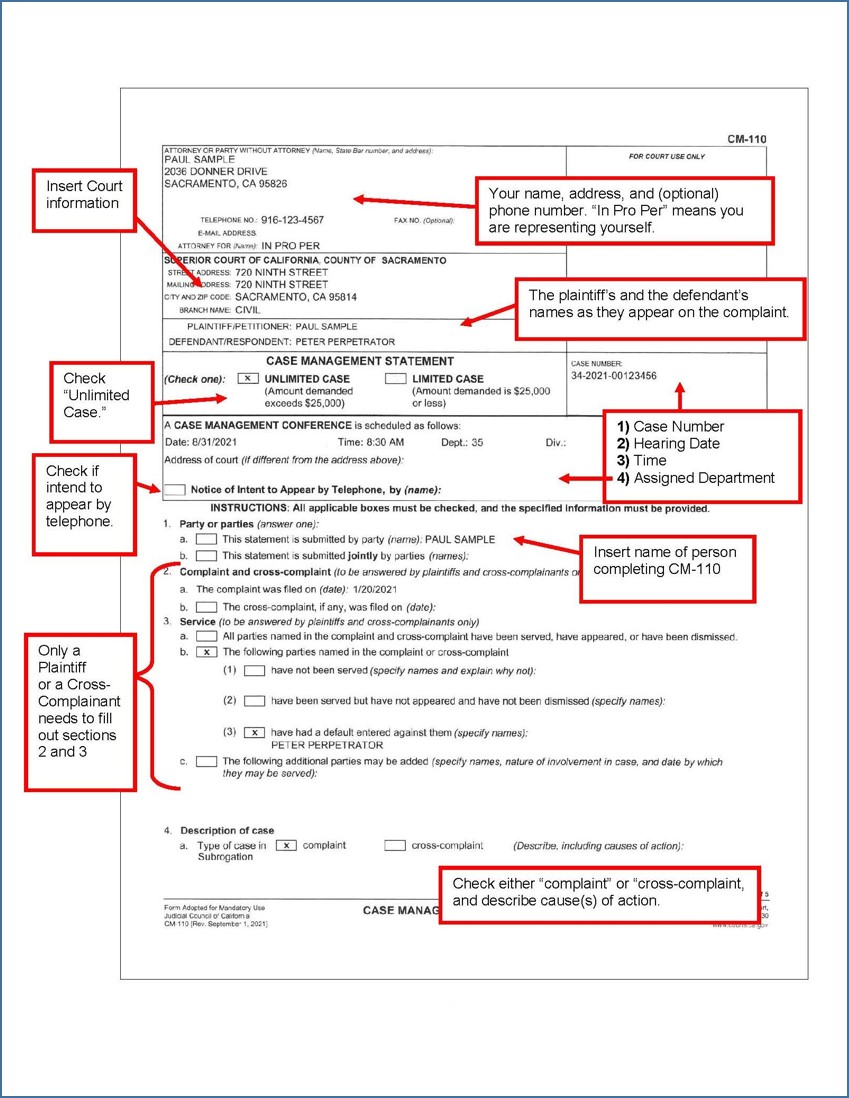
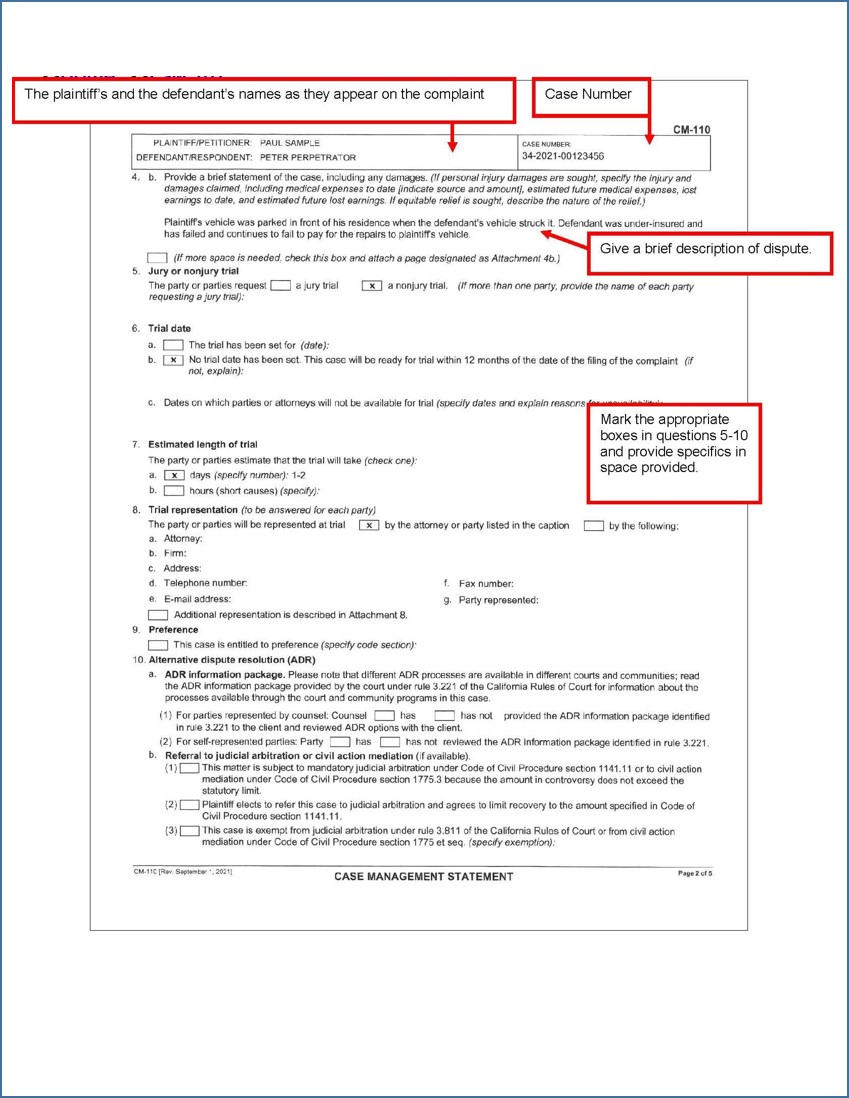
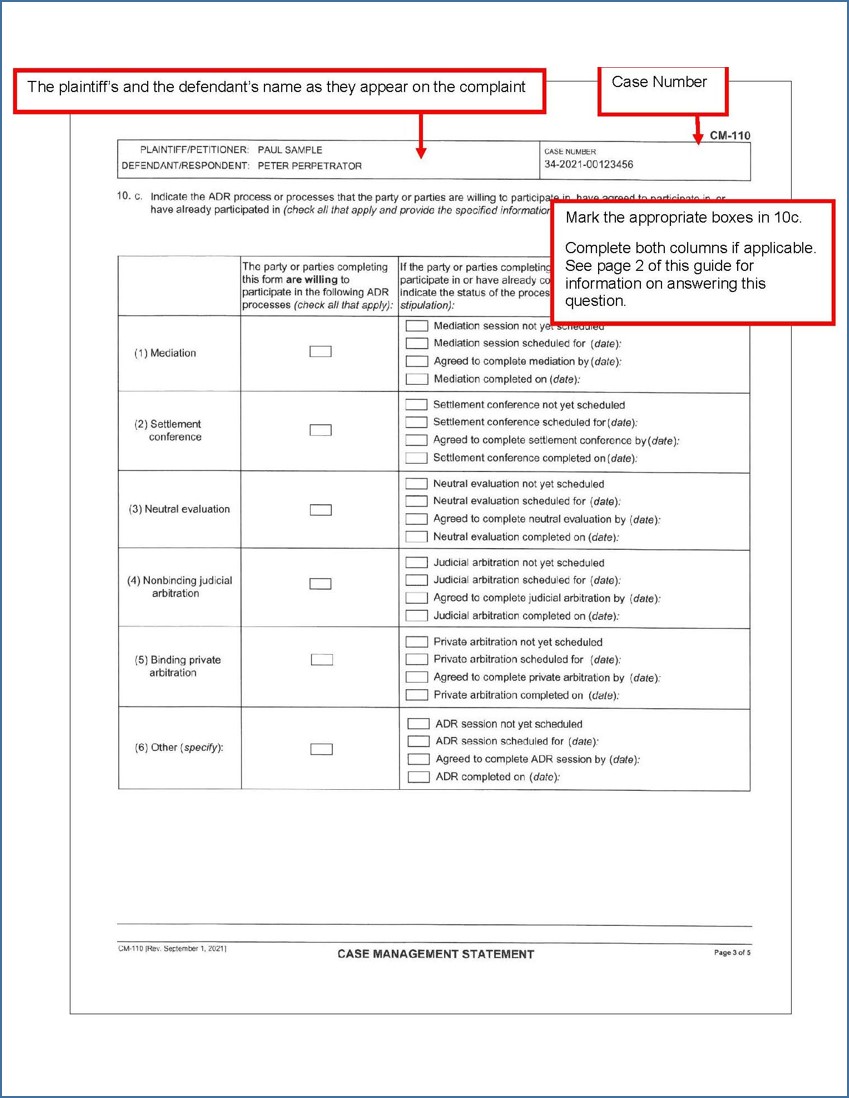
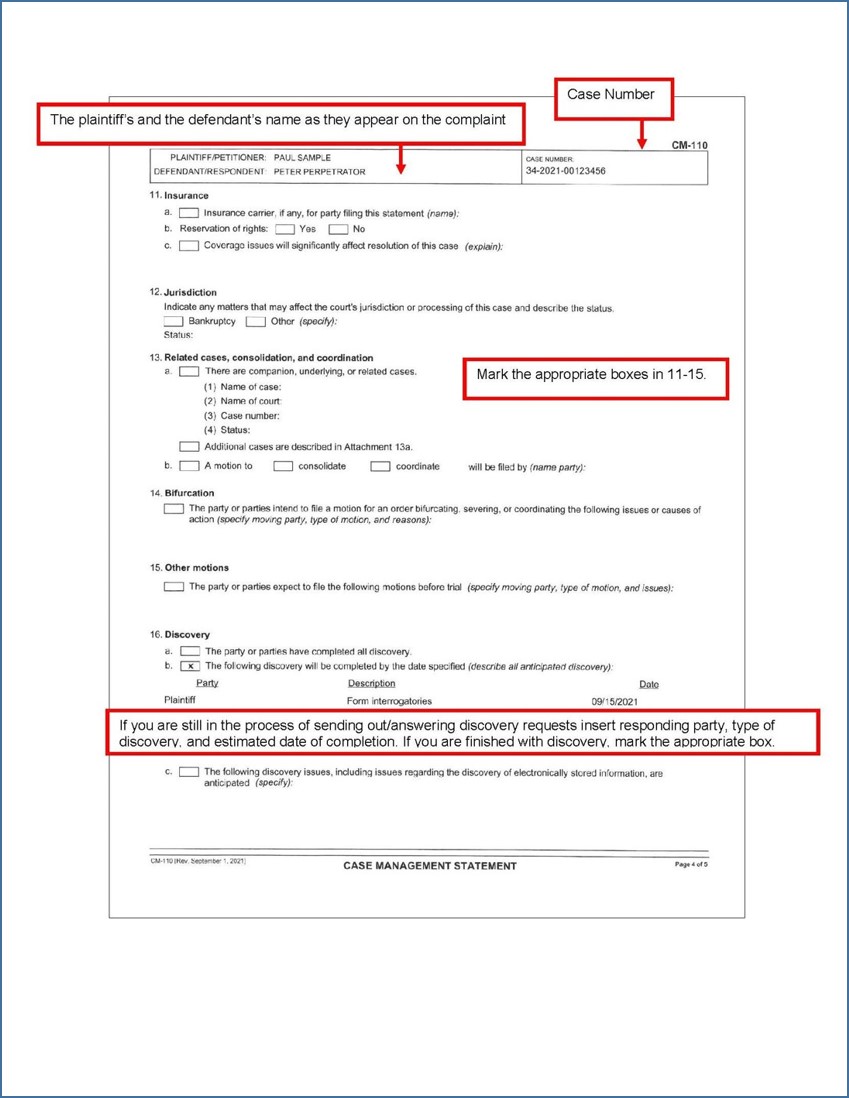
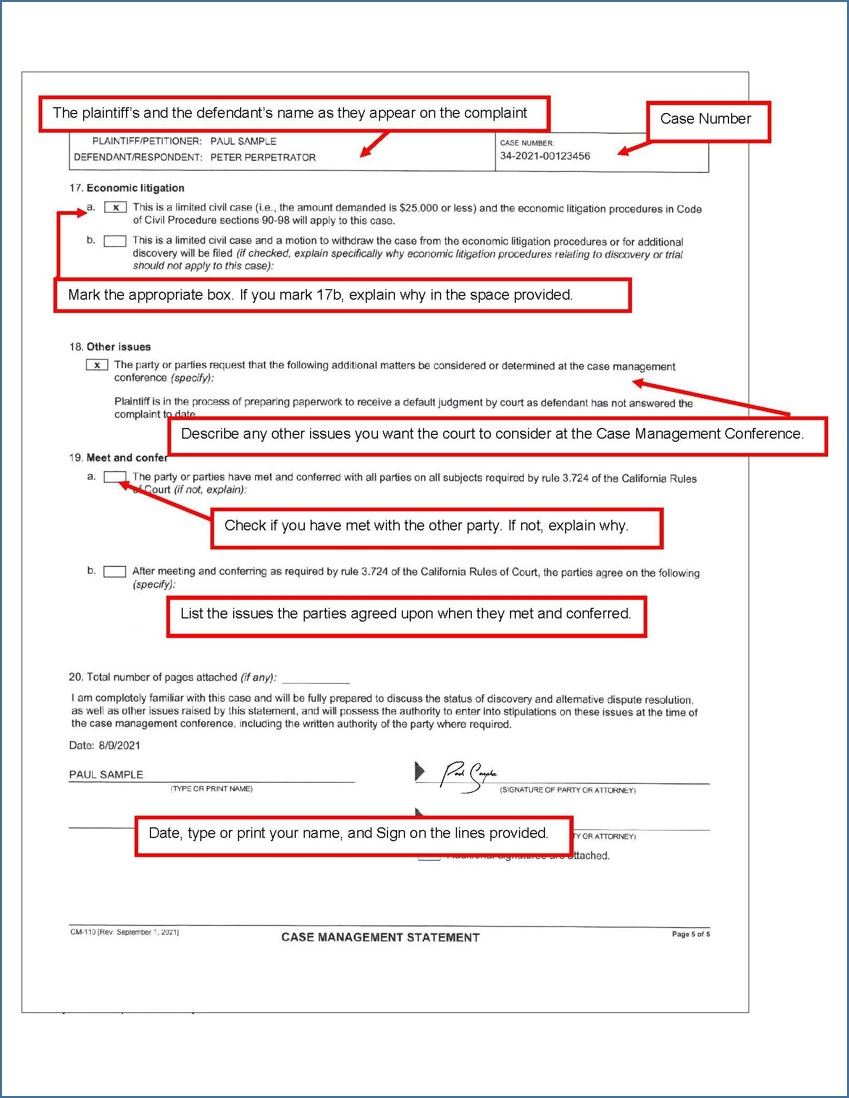
This material is intended as general information only. Your case may have factors requiring different procedures or forms. The information and instructions are provided for use in the Sacramento County Superior Court. Please keep in mind that each court may have different requirements. If you need further assistance consult a lawyer.






